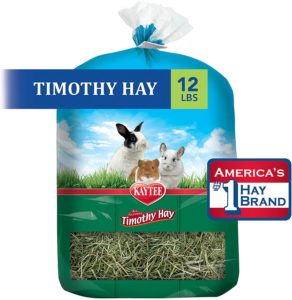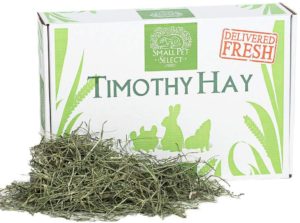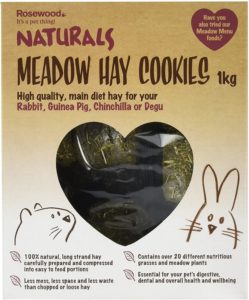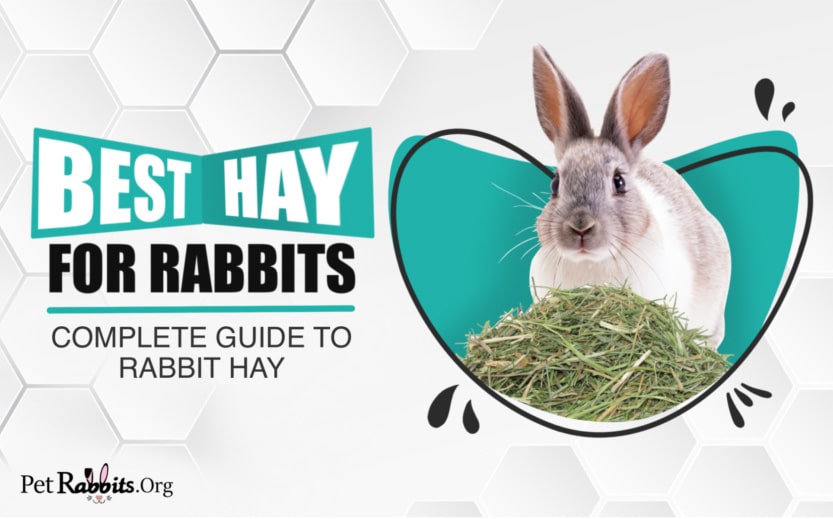The term “rabbit food” has long been used to describe salads and anything healthy humans don’t want to eat. However, there are some misconceptions about the best food for rabbits. Hay is a crucial part of their diet. But what is the best hay for rabbits?
In this guide, you will learn why rabbits need free-choice hay daily and the best hay choices for your rabbit. We will discuss the benefits of hay and the different types available. Then we will dive a little deeper into some of the top brands and their best products. From there, we have a short buyer’s guide to help you choose good-quality hay. Finally, we have some tips about feeding pet rabbits.
If you are looking for a hay feeder, use our guide for the best hay feeders for rabbits.
Why Do Rabbits Need Hay?
Let’s start with the reasons why your rabbit needs hay in the first place. Hay is crucial to a rabbit’s overall health and well-being. Hay should be fed free-choice when your rabbit is in its enclosure, out getting exercise, and be available in the carrier when traveling. It needs to be available 24/7. Rabbits enjoy eating hay and it helps to maintain their dental and gut health. Hay can help with the following:
- Provide a key source of fiber for good gut health. Hay-free diets lack fiber and this can lead to many health problems for your pet rabbit. Rabbits need a high-fiber diet to thrive.
- Help to prevent digestive stasis. This is a dangerous condition where the gastrointestinal tract stops functioning properly and commonly occurs due to a lack of fiber and other nutrients in their diet. See our article on what to do if your rabbit is not eating. This article discusses digestive stasis and other related health problems.
- Maintain appropriate body calcium levels. It is easy for rabbits to end up with too much calcium in their diets through pellets and other sources. Excess calcium can lead to kidney stones, other calcified deposits in the body, and other health issues.
- Rabbits do not need commercial treats; what they need is hay!
- Hay encourages foraging behavior. Rabbits are grazers by design. While it is nice to allow your pets access to fresh grass outside, there are health risks and safety concerns with doing so 24/7. Hay enables them to eat throughout the day.
- Regularly chewing on hay helps maintain dental health. Finally, all that grazing on hay is perfect for keeping your pet’s teeth in good shape. Rabbit teeth constantly grow and wear down. They do so by eating the appropriate amount of hay and greens. Chewing on hay occurs with a side to side and circular type motion which helps to file their teeth down evenly. Chewing on pellets uses an up and down motion and contributes to abnormal teeth and obesity.
How long do pet rabbits live? If you want your rabbit to live a long and healthy life, then make sure you take care of its health. If you follow our advice on diet and feeding habits for your pet rabbit, he/she will be able to live longer and happier.
What Kind of Hay do Rabbits Eat?
Next, we need to look at the different types of hay readily available. Various forms have their own look and feel with varied nutrient profiles. Once you find the right type, you can then move on to finding your brand.
Grass hays include timothy, oat, and orchard:
Timothy Hay
First up, we have one of the most popular forms of hay – Timothy hay. This is also one of the most commonly recommended for pet rabbits.
This one comes in three forms, and you can choose between them for the best fit. They are:
1st cutting:
This high-fiber hay is perfect for rabbits that currently lack fiber in their diet. This consists primarily of a lot of stems and few leaves. But it can be a bit hard, and many rabbits may not take to it.
2nd cutting:
The typical rabbit diet usually consists of this type of cutting. There are good levels of fiber, fat, and protein for a nice balance. You get a nice blend of flexible stems and a good amount of leaf at this point.
3rd cutting: Then there is the 3rd cutting, where it is all about the green leaves. This can be a great tasting option with a lot of protein. But, be aware that there is also a higher fat content. Learn more on our Kaytee Timothy Hay Review.
If using this as a guide, 2nd cutting should be fed to healthy rabbits. If you choose one of the reputable commercially prepared products, you don’t have to worry about this as they aim to get the nutrition levels appropriate for fiber, fat, and protein.
Oat Hay
Oat hay is a great alternative, especially if you need to increase the fiber content in your pet’s diet. In fact, a lot of rabbits adore it. Don’t be put off by the more yellow color. It is still fresh and beneficial.
Orchard Hay
This alternative hay isn’t the best choice for a regular diet but can still work as a supplement or a starter when switching diets. Add it into the Timothy hay now and then to keep things interesting.
Legume hays include Alfalfa, clover, peas, beans, or peanuts.
Alfalfa Hay
This is hay that many people commonly reach for in pet rabbits. But it really should only be fed as a treat or supplement because it is so rich in calories, protein, and calcium that it can be too rich for pet rabbits.
Some pet parents prefer to use this with their younger rabbits before moving on to an adult diet. It gets the youngsters used to hay from an early age. However, it is much sweeter, and if you start with this, it can be a challenge to switch some rabbits to the more appropriate grass hays. Many veterinarians do not recommend feeding this at all. We do not want a rabbit only to eat alfalfa and not the grass hay, which it needs for survival and health management.
Additional grass hays include meadow, rye, barley, or bermudagrass. Ideally, consider providing mixed grass hay or two different types to ensure a well-balanced mix.
Ideally, sun-dried hays are healthier than commercially dried hays.
Remember, never to feed straw.
Learn More:
The Best Brands of Rabbit Hay
Now that you know a little about the different types of hay for rabbits, you need to find a brand and an appropriate product. The following are all highly rated with great ingredients and benefits.
Kaytee
Kaytee claims to be America’s number one brand. This isn’t a surprise given their range of products. The first Kaytee option is this simple bag of Timothy hay. This incorporates a blend of both 1st and 2nd cut hay types. The idea here is that you get the best of both worlds. Just open it up, grab a handful and seal it tight.

But remember, alfalfa is not recommended as the primary hay source for adult rabbits!
If you are interested in learning more, go to our Kaytee timothy hay review.
Oxbow
This brand has a lot of impressive claims about its product. Oxbow is a 100% natural hay grown in the USA that is high-quality Timothy hay. It is hand-sorted and hand-packed for quality control. The smallest is 15oz, and the largest is 90 oz.
Small Pet Select
This company is popular with pet owners because of its focus on quality and freshness. They go out of their way to make sure that they package the best hay and do so in eco-friendly cardboard boxes. This option is their “Perfect Blend” 2nd Cutting Timothy Hay. This means that it is quality hay for all rabbits with good stems and flower heads. You can also choose the size of the box from 2 lbs up to 25 lbs.

Rosewood
If you like the idea of compressed bales, these cookies may also be of interest. These cookies take large amounts of hay and compress them down into tiny bundles. It is easy to place them in the hutch and let rabbits gnaw on them. These are said to have over 20 different plants with quality hay and 54% fiber.

Vitakraft
Then there is Vitakraft with their take on American-grown, naturally-sourced hay. Again, this is Timothy hay, which highlights the popularity of this form over other options. They class it as sweetgrass hay, which suggests freshness and great enjoyment for your pet. They also work to compress the bales tightly for a lot of hay in one package.
Kaytee and Oxbow brands are the most commonly used by veterinarians in the US.
How To Choose High-Quality Hay for Rabbits
The products above are all great examples of what you can get in high-quality hay. But, if you are ever in a pet store looking for emergency supplies, consider the following when selecting from unknown brands.
- Look at the color of the hay. Hay shouldn’t be the color of straw. Instead, it should look more like grass.
- Look at the texture of the hay. Has it dried out? Is it past its expiration date? Or is it damp due to poor storage and at risk of mold?
- How does it smell? This might not be apparent with shrink-wrapped bundles, but it should have a sweet smell with no sign of any mold or dust.
- If you are buying hay from a feed store and not commercially prepared hay, don’t purchase from the top of the pile. Instead, get a protected portion between the layers. This minimizes the contamination from bird and other animal droppings.
10 Tips For Feeding Rabbits Hay
Before we give our final thoughts on the best hay for rabbits, here are 10 tips and facts that you should know about feeding your rabbit. These should help you give your pet the very best feeding experience and nutrition for their health and well-being.
- Make hay the dominant part of your rabbit’s diet starting at weaning age. Did you know that hay should make up 80 – 90% of a rabbit’s diet? That sounds like a lot, but it is essential for those health benefits mentioned above. This means at least one bundle per day, and that bundle should be the same size they are.
- Choose the rest of the diet carefully. Be careful when choosing the rest of the diet. Leafy greens are essential for your pet’s nutrition. They provide additional nutrients such as vitamins and minerals your rabbit needs. A good rule of thumb is one heaping cup (8 oz) per 3 pounds of body weight daily.
Some veterinarian-approved greens include:
- Swiss chard, carrot tops, broccoli (leaves and tops only), raspberry leaves, spinach, green peppers, cilantro, among many others
- However, many greens are also high in calcium and shouldn’t be fed every day, such as collard greens, mustard spinach, turnip greens, kale, parsley, or dill weed.
Always ensure when feeding greens that you
- Wash them well first to prevent infectious disease.
- Ideally, organic is preferred to prevent pesticide exposures.
- Feed a variety of greens daily. Feed a minimum of 3 different types per day. The array allows for mental enrichment and provides a variety of nutrients for your pet rabbit.
- What about carrots for rabbits? There isn’t anything wrong with giving your rabbit a carrot as a treat occasionally. But don’t trust all those Bugs Bunny cartoons. This isn’t a primary part of their diet. What they need are the carrot tops, not the orange veggie.
- You can give them the chance to graze on grass but know this does increase their risk of infectious diseases such as intestinal parasites. Ensure the grass has never been treated with pesticides or other chemicals.
- Don’t feed them lawnmower clippings. This is an easy mistake for rabbit owners to make if they decide to add grass to their pet’s diet. You might think that this is just the same and an easy source of food. But, the lawnmower destroys the grass blades so much that they lose nutrients and freshness. In turn, this could make your rabbit ill and will not provide proper needed nutrition.
- If you use rabbit pellets at all, they should only be as a treat.
Rabbit pellets are a simple and easy way to feed pet rabbits. But, they are not necessary. Pellets are never needed when fed a well-balanced diet of grass hay, greens, and a few fruits. If you want to provide a treat, however, pellets are healthier than the formulated rabbit treats. The treats are usually high in sugar and carbohydrates that they cannot easily digest. Rabbits fed a large part of their diet as pellets often suffer from obesity, dental disease, and GI disease.
- Never forget about their water needs. Fresh, clean water is essential for health and hydration. Try and use a ceramic bowl where possible as this is a cleaner, more rabbit-friendly approach. A water bottle can be trickier to use and get jammed. They also carry risks of plastic leaching into the water.
- Always keep hay in a safe place.
This is their lifeline. It needs to remain fresh, healthy, and tasty all day long. Don’t leave it somewhere where it can get dusty and damp. Dampness just invites mold.
- Use our guide on the best hay feeders for rabbits to find the best way to feed your pet rabbit.
- Make sure to remove old hay and add fresh hay daily.
Old hay can get soiled with urine or feces and will decay over time, losing nutrient content. Always remove uneaten hay daily and replace it with fresh hay.
- If you have any doubts or concerns, contact your veterinarian.
- There will be times when rabbits go off their food or go through health issues requiring additional nutritional help. Your vet will be able to point you in the right direction and make recommendations. They can also give your pet a check-up to be sure there are no additional medical issues. You can even contact a vet through our video live call option. See more details here.
What should you do if your rabbit won’t eat hay?
If your rabbit turns its nose up to the hay and you currently feed pellets, slowly decrease the number of pellets and increase the amount of fresh greens and hay provided. Over time most rabbits adapt because it is what their body craves.
If they still don’t seem to be eating enough hay, you could add a hint of alfalfa or some pieces of fruit, such as a piece of pineapple or blueberry or two. (See our article on the proper fruits and veggies to feed your pet rabbit).
You could throw in some herbs or flowers to pique their interest but make sure to check that they are safe for rabbits.
Ensure that their enclosure or exercise space is free from clutter, other animals such as cats or dogs, and not too cold or hot. And finally, try a few different brands of hay and, if needed, a variety of grass hays to find which they may prefer.
The Best Hay For Rabbits
The best rabbit hay depends on your rabbit’s medical needs and age. The most commonly fed and veterinary recommended hay is a good quality, 2nd cutting grass hay, like timothy hay.
For more general rabbit information, go to:
Use the comments below to tell us about your bunnies rabbit hay. Do you have any additional tips about rabbit hay?
I have always loved rabbits. A rabbit was my very first pet. Since owning my first rabbit I have gone on to own many more. I look forward to being able to get my kids their very own pet rabbits.


Hello Petrabbits.org How can I get American Pet hay and products to be reviewed by you to be included in the best hay for rabbits section? Thank-you lisam@americanpet.com
Hello! We would be happy to review your rabbit hay and products to include in our content. We will send you an email.
Thank you!